Giochi dell'Oca e di percorso
(by Luigi Ciompi & Adrian Seville)
(by Luigi Ciompi & Adrian Seville)

|
Giochi dell'Oca e di percorso
(by Luigi Ciompi & Adrian Seville) |

|
 |

Torna alla ricerca giochi (back to game search) |
 |
| Wallis's New Game of Universal History and Chronology | ||
 |
Versione stampabile
 |
Invia una segnalazione

|
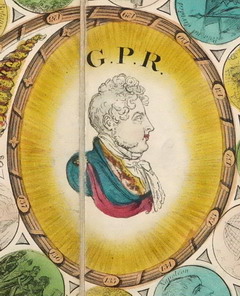 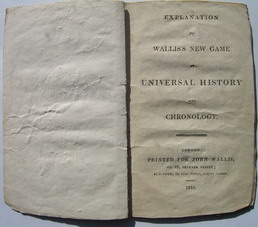 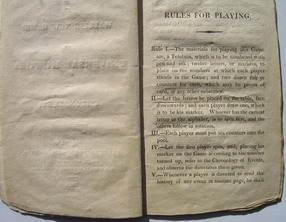 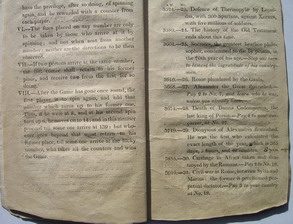 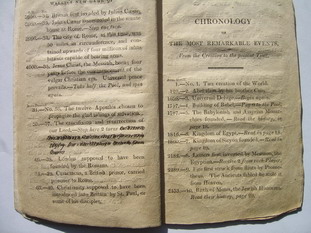 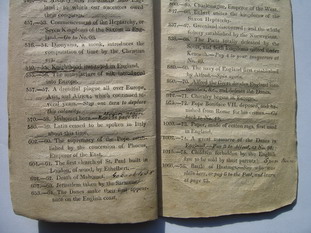 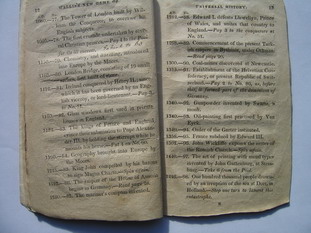 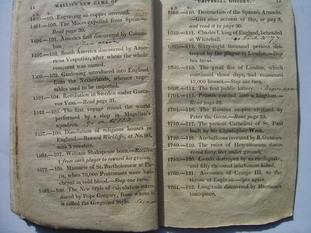 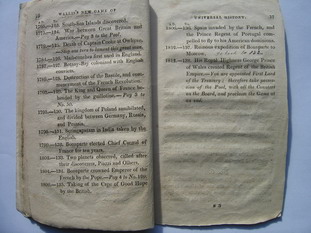  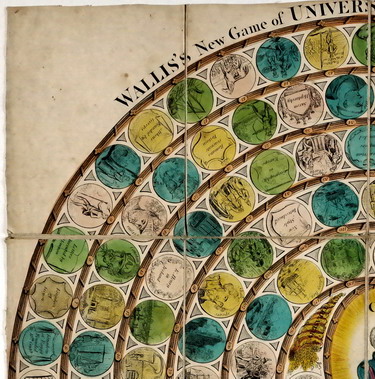 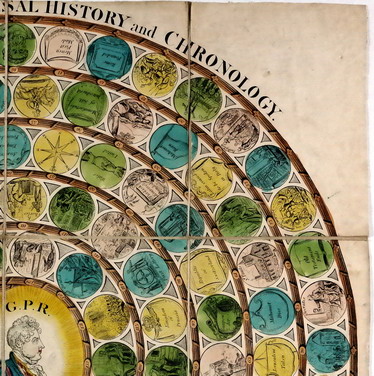 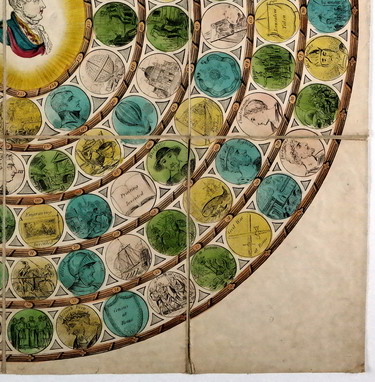 |
primo autore: | Cruikshank, Isaac Robert |
| secondo autore: | Wallis | |
| anno: | 1814 | |
| luogo: |
Inghilterra-Londra |
|
| periodo: | XIX secolo (1°/4) | |
| percorso: | Percorso di 138 caselle numerate | |
| materiale: | carta incollata su tela (engraving on paper with linen backing) | |
| dimensioni: | 508X495 | |
| stampa: | Litografia colorata a mano (hand-coloured engraving) | |
| luogo acquisto: | ||
| data acquisto: | ||
| dimensioni confezione: | 200X140 | |
| numero caselle: | 138 | |
| categoria: | Personaggi ed eventi storici | |
| tipo di gioco: | Gioco di percorso | |
| editore: | Wallis, John 42, Skinner Street, Snow Hill, London | |
| stampatore: | Wallis, John 42, Skinner Street, Snow Hill, London | |
| proprietario: | Collezione A. Seville | |
| autore delle foto: | A. Seville - L. Ciompi | |
| numero di catalogo: | 854 | |
| descrizione: |
Gioco di 138 caselle numerate, circolare, orario, centripeto con al centro l'immagine del Principe Reggente (G.P.R.) futuro Re Giorgio IV. Le regole sono contenute in un libretto allegato. Questo gioco stampato il 20 Maggio del 1814 verrà ristampato modificato nel 1840: al posto dell'immagine centrale del Principe Reggente verranno introdotte 5 nuove caselle. REGOLE: vedi allegato. CASELLE: alcune con didascalia. PERSONAGGI: Socrates; Alexander the Great, 356-323 B.C.; Darius I King of Persia, 548-485 B.C.; Dionysius I, ca. 430-367 B.C.; Caesar, Julius; Jesus Christ; Constantius I Emperor of Rome, d. 306; Muhammad Prophet, d. 632; Charlemagne Emperor, 742-814; Alfred King of England, 849-899; Henry I King of England, d1068-1135; Wycliffe, John, d. 1384; Columbus, Christopher; Gustaf I Vasa King of Sweden, 1496-1560; Shakespeare, William, 1564-1616; Charles I King of England, 1600-1649; George III King of Great Britain, 1738-1820; Napoleon I Emperor of the French, 1769-1821; Fergus; Pharamond; Egbert II, King of England. NOTA: vedi altro esemplare Arch. n°545 REFERENZA 1 "Wallis's New Game of Universal History and Chronology" . (V&A Museum). This is a race game designed to teach history. There are138 playing spaces numbered in a clockwise direction. The starting point is Adam and Eve. The first 75 spaces deal with events before 1066. Each has a date, starting with Anno Mundi 1. In the centre is George, the Prince Regent, later George IV. The accompanying booklet has a list of all the spaces with their titles and dates. Some have additional information and some have instructions on rewards and forfeits. Physical description Design: engraving, hand coloured; paper, 12 sections mounted on linen 138 compartments numbered in a clockwise direction with No. 1 in the lower left corner N°of squares: 138 Squares illustrated: all Square numbering: numbered 1 to 138 Squares titled: none, see booklet Subject of starting square: creation of the world Subject of ending square: George, Prince of Wales, 1812 Place of Origin: London Date: 20/05/1814 Artist/maker: Wallis, John Materials and Techniques: Hand-coloured engraved paper on linen Dimensions: Length: 53 cm; width: 53 cm. Cover: Length: 20 cm; width: 14 cm Object history note: The first 75 squares deal with events before 1066, each has a date, starting with Anno Mundi 1 and all dates are given with conviction - for example, the Universal Deluge occurred in AM1636-one wonders if this knowledge was lost between 1814 and today. In the centre is George, Prince Regent. The game was reworked and issued about 1840 and had 5 compartments replacing the portrait. Historical context note Rewards: receipt of counters Forfeits: payment of counters No. of Players: up to 12 Equipment required: teetotum, markers and counters Rules: EXPLANATION TO WALLIS'S NEW GAME OF UNIVERSAL HISTORY AND CHRONOLOGY, LONDON PRINTED FOR JOHN WALLIS No. 42 SKINNER STREET; BY F. VIGURS, 14, YORK STREET, COVENT GARDENS, 1814 RULES FOR PLAYING Rule 1. The materials for playing this Game are, a Teetotum, which is to be numbered with pen and ink; twelve letters, or markers, to place on the numbers at which each player stands in the Game; and two dozen fish or counters for each, which may be pieces of card, or any other substance. II. Let the letters be placed on the table, face downwards; and each player draw one, which is to be his marker. Whoever has the earliest letter in the alphabet, is to spin first, and the others follow in rotation. III . Each player must put six counters into the pool. IV. Let the first player spin, and, placing his marker on the Game according to the number turned up, refer to the Chronology of Events, and observe the directions there given. V. Whenever a player is directed to read the history of any event in another page, he shall have the privilege, after so doing, of spinning again, and be rewarded with a counter from each player. VI. The fines placed on any number are only to be taken by those who arrive at it by spinning; and not when sent from another number; neither are the directions to be then observed. VII. If two persons arrive at the same number, the last comer shall return to his former place, and receive two from the first for so doing. (This is the opposite to that of Game of Human Life).. VIII. After the Game has gone once round, the first player is to spin again, and add that number which turns up to his f ormer one. Thus, if he were at 8, and at his second spin turn up 6, he moves to 14; and in this manner proceed till some one arrive at 139; but whoever goes beyond that must return to his former place, till some one arrive at the lucky number, who takes all the counters and wins the game. Within the booklet is a list of the squares; their titles and the dates applied to each, for example ANNO MUNDI 1 The creation of the World and AM 1656 The Universal Deluge.. Also within the booklet are the OUTLINES OF HISTORY given for some but not all the squares. These also contain some rewards and forfeits instructions and in general are meant to be read aloud by the players who land on the chosen squares. Rules placement: booklet, 34 pages with two pages of advertisements. Descriptive line: Hand coloured historical race game, Universal History and Chronology, published in England by John Wallis in 1814. Attribution Note: Booklet printed by F. Vigurs, 14 York Street, Covent Garden REFERENZA 2 WHITEHOUSE, Francis Reginald Beaman, (pag. 28-29): UNIVERSAL HISTORY & CHRONOLOGY Wallis's new game of, May 20. 1814. Published by John Wallis, 42, Skinner Street, Snow Hill, London. An engraving hand-coloured, size 20 in X 20 in, comprising 137 circles. In the centre is a portrait of George, Prince Regent. A dealer’s catalogue description of this game is as follows: "Centre: a portrait of George, Prince of Wales. May 20. 1814. The plate is probably the work of Robert Cruikshank, the drawing being in his style and his period. RARE.” The book of rules, printed by F. Vigurs, 14 York Street, Covent Garden, is of 34 pages and explains the 137 pictures, e.g.: Anno Mundi 1 The Creation of the World 1656 Universal Deluge 2182 Letters first invented by MEMNON the Egyptian 3252 Rome founded 3589 The History of the Old Testament ends about this time Anno Domini 604 The first Church of St. Paul built in London by Ethelbert 1000 Paper made of cotton rags first used in England 1775 War between Great Britain and America 1793 King and Queen of France beheaded by Guillotine 1804 Buonaparte crowned Emperor of the French. REFERENZA 3 "Cependant, certains jeux commencent à partir d'Adam et Eve. Sur les 138 cases illustrées du New Game of Universal History and Chronology (Nouveau jeu de l'histoire et de la chronologie universelle) de John Wallis, les 75 premières sont consacrées à des événements antérieurs à 1066. Chaque case est datée, commençant par l'an 1 de notre ère, et toutes les dates sont précises meme si certaines nous paraissent aujourd'hui assez fantaisistes et peu crédibles - par exemple, ici le Déluge date de 1636 av. J. C.. Au centre se trouve George, prince régent (futur roi George IV). Une autre version éditée vers 1840 avait cinq compartiments au lieu du portrait. Parmi les nouveaux sujets se trouvait également le roi Guillaume IV et la reine Victoria, le mariage de la reine Victoria et une locomotive. Le règlement qui accompagnait le premier exemplaire donnait de brèves descriptions sur chaque case et quelques instructions et à la fin du livret se truvaient de longues descriptions de certains des sujets qui devaient etre lus à haute voix si un des joueurs tombait sur un certain nombre. Ce jeu est une gravure peinte à la main, édité le 20 mai 1814 par John Wallis". (GOODFELLOW Caroline) REFERENZA 4 "A few games do, however, begin with Adam and Eve. Out of the 138 compartments illustrated on John Wallis's "New Game of Universal History and Cronology", the first 75 are devoted to events before 1066. Each compartment has a date, starting at Anno Mundi 1 and all the dates are given with such conviction - for example, the Universal Deluge occurred in AM 1636 - that one wonders if this knowledge was lost between 1814 and today. In the centre is George, Prince Regent (later King George IV). A reworked impression of this game was published in about 1840, and had five compartments replacing the portrait. Among the new subjects were King William IV and Queen Victoria, and a railway train. Both versions of the game were hand-coloured. The rules booklet that accompanied the earlier example gave brief descriptions of each compartment and some directions, and at the end of the booklet were longer descriptions of some of the subjects, which had to be read aloud if a player landed on the revelant number. The game was a hand-coloured engraving published by John Wallis on May 20th 1814". (GOODFELLOW Caroline) REFERENZA 5 Game 32: Universal History and Chronology New Game of Universal History and Chronology. London: [John Wallis, 42 Skinner Street, 1814]. Copper engraving with original hand color, 50 x 50 cm., dissected and laid onto linen with 3 x 4 panels. Refs.: Ciompi/Seville 0854; Whitehouse, pp. 28 - 29. Unlike the earliest English geographical games, their counterparts focussing on history had no connection with Goose. The density of instruction was increased by the use of a separate rule booklet, giving more detail than could be shown on the playing surface but at the cost of slowing down the game. Published in the fourth year of the Regency, with George Prince Regent depicted on the winning space at no. 138, the engraved game sheet was accompanied by a 24-page booklet (Exhibit 32a) giving the rules to be observed on the individual spaces, which constitute a chronological track of historical events. The pages that follow give the histories of certain events that are judged important and are to be read out by the player landing on them, who gets another spin and is rewarded with a counter from each player. The choice of important events is to our modern minds a little obscure, e.g., no. 5 ”Babylonish and Assyrian monarchies founded AM 1787.” However, none can quarrel with the selection of no. 10 ”Birth of Moses AM 2433” or no. 16 ”Birth of Homer - if you can say who he was and what he wrote receive 2 from each player; otherwise place 6 [counters] on 13 [Trojan War] and learn there.” The selection of the Birth of Mahomet (no. 58) as an important historical event is an encouraging indication of some breadth of religious understanding in Regency times; but this positive view was evidently too challenging for the owner of this copy of the booklet, where the relevant rule has a chilling manuscript addition - begin again. This is an example of another kind of social interaction with the game apart from simply playing it - the imposition of local rules. (Adrian Seville) Exhibitions: - "The Royal Game of the Goose four hundred years of printed Board Games". Exhibition at the Grolier Club, February 23 - May 14, 2016 (Prof. Adrian Seville). |
|
| bibliografia: |
1) GOODFELLOW, Caroline: "Jeux de société. Le guide du collectionneur des jeux de société depuis le XVIIIe siècle jusqu’à nos jours", (Edizione francese) Carrousel MS, 2001. 2) GOODFELLOW, Caroline: "A Collector's Guide to Games and Puzzles" Secaucus, New Jersey, Chartwell Books-London, Quintet Publishing Limited 1991. 3) GOODFELLOW, Caroline: "The Development of the English Board Game, 1770-1850", in Board Games Studies 1, 1998. 4) SEVILLE, Adrian:"The sociable Game of the Goose" in "Board Games Studies Colloquia XI", 23-26 Aprile 2008, Lisbona - Portogallo 2008. 5) WHITEHAUSE, F.R.B.:"Table Games of Georgian and Victorian Days", London, Peter Garnett, 1951 (pag. 25). 6) SEVILLE, Adrian:"The Royal Game of the Goose four hundred years of printed Board Games". Catalogue of an Exhibition at the Grolier Club, February 23 - May 14, 2016. 7) PARLAK, Ömer Fatih: "The Image of the Turk in Early Modern Board Games and Playing Cards". PHD THESIS. Universitat Autonoma de Barcelona, 2019. |
|
| "The Development of the English Board Game", 1770-1850 (Caroline G. Goodfellow) | ||
| Historical Games. "Table Games of Georgian and Victorian Days". (Francis Reginald Beaman, Whitehause) | ||
Vai alla ricerca giochi Vai all'elenco autori